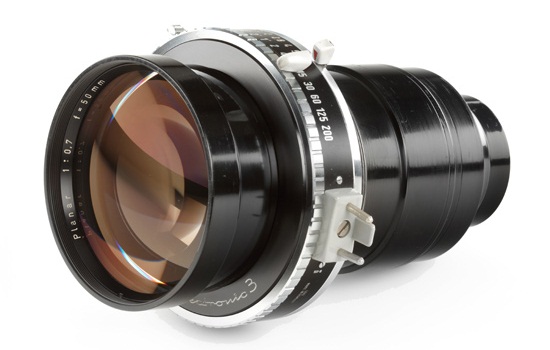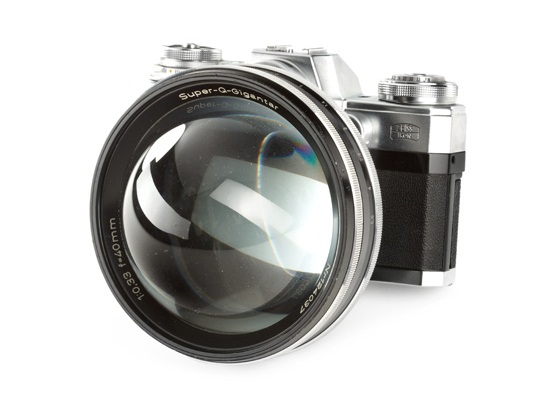… which you might have known already. There are several C-mount lenses with speed ratings well below 1:1 (for example the Fujinon 25mm f/0.85), but also lenses for 35mm. Recently 43rumors reported on a Kowa 42mm f/0.75 lens. Then there’s the crazy Rodenstock 50/0.75, and a lens with the same specifications has also been made by De Oude Delft.
The most famous über-fast lens though is probably the legendary Zeiss Planar 50/0.7, originally developed for NASA and later used by Stanley Kubrick for filming candle-lit scenes for the motion picture “Barry Lyndon”. There was even an adapter made turning it into a 36.5mm wide angle, for those scene needing a wider perspective.

The famous Zeiss Planar 50/0.7 used by Stanley Kubrick in "Barry Lyndon". Picture © WestLicht Photographica
But this is not where it ends … not by far! WestLicht Photographica, affiliated with Leica Shop Vienna, are currently auctioning what they claim is “the fastest lens in the world” — the Carl Zeiss Super-Q-Gigantar 40mm f/0.33. Yes, you read correctly, it’s a 40mm lens with an f/0.33 speed rating, meaning an aperture diameter of 12cm = 4.7 in! According to their website, the Gigantar was developed for advertising purposes. But it IS a REAL lens! And it can be yours — starting from € 6.000 with an estimated high of € 16.000!

The Zeiss Super-Q-Gigantar 40mm f/0.33, claimed fastest lens in the world. Picture © WestLicht Photographica
Oh, and while we’re at it, they’re also auctioning the 50/0.7 Planar. Yes, that Planar! Starting bid is € 9.000, estimated high is € 20.000. Bargain, if you ask me …
EDIT: According to this Italian website, the Super-Q-Gigantar never was a real lens to begin with. Rather, it was Zeiss’ answer to voices asking for more fast lenses. In fact, the Gigantar isn’t actually capable of producing what one would call a “photograph” …



f/0.33 Euh….
Unfortunately, the laws of optics forbid apertures beyond f/0.5 for a refractive lens! a diameter exceeding 2F is deceiving!
For such an ideal lens, the rays would cover the whole half space. The reason is that the f number ( e.g. 2.8 or 11) defined as the ratio of the focal length to the diametre of the input pupil is an approximation for 1/2NA, and the numerical aperture NA is nsin(u), where n is the refractive index of the medium, (1 for air) and u the angle between the outermost rays and the incident ray.
NA governs light collection and diffraction limited resolution of lenses.
The approximation is acceptable up to f/1, but starts to deviates very strongly beyond. In case of a total coverage, this angle would be 90° and even with an infinitely wide lens, NA would not exceed 1 in air (up to 1.4 in immersion microscope lenses). Light collected in the outer part of the lens would simply not reach the focal point.
Only can a concave mirror collect light that reach the focal point from more than 2pi steradians, but then you cannot place a sensor !
Thanks for your comment! Meanwhile, I believe I read somewhere that this lens was a marketing gag more than anything else.
[…] […]
[…] Que en realidad fue todo una broma y publicidad del RRPP de Zeiss y que sus valores son un simple invento de el. La falta de imágenes de ejemplo y la clara desinformación que hay en la web indicaría que este […]